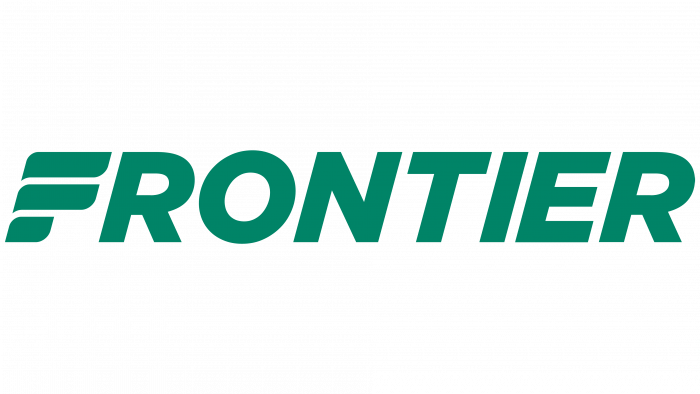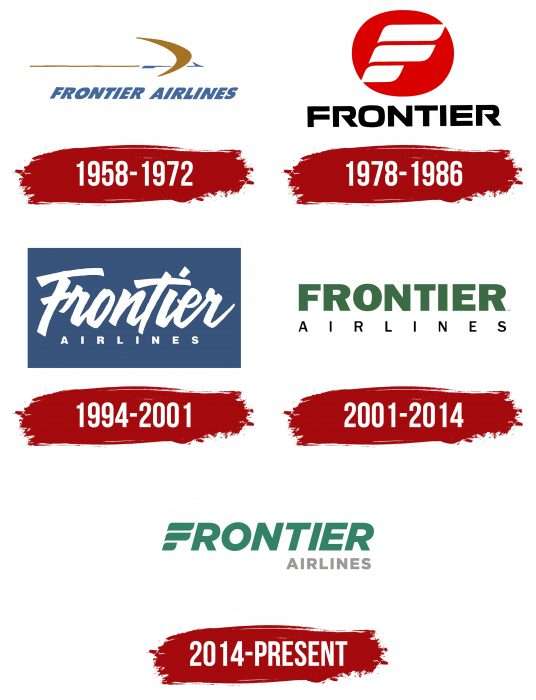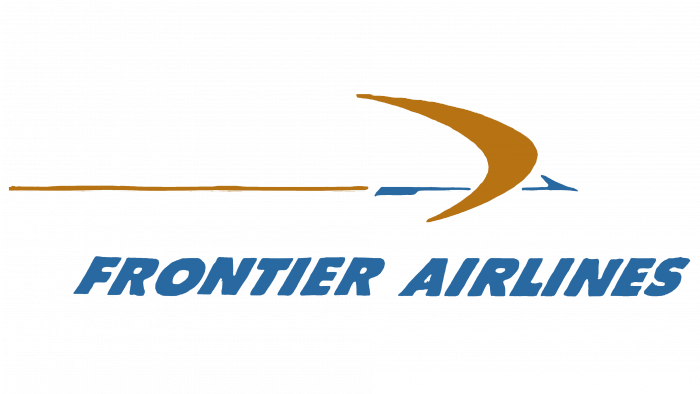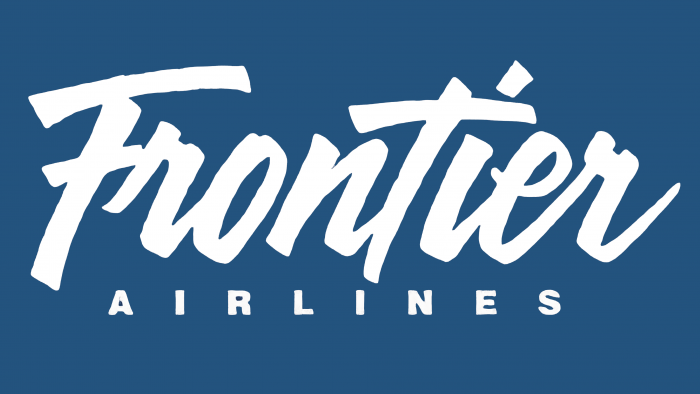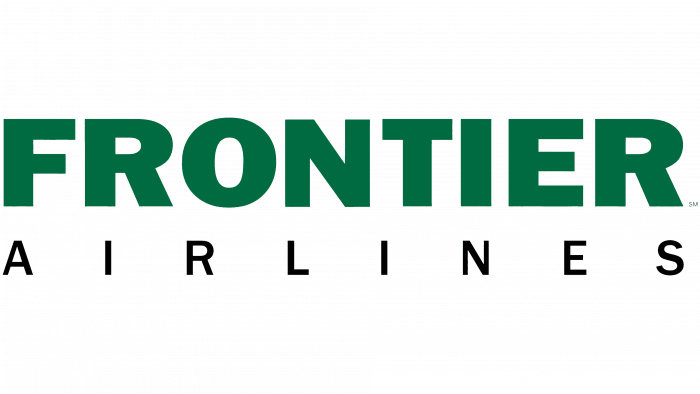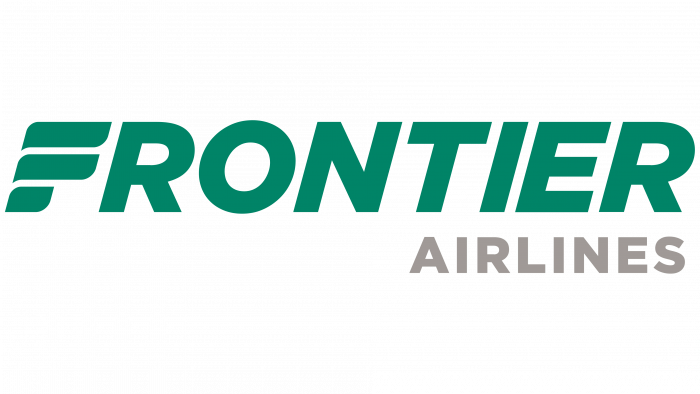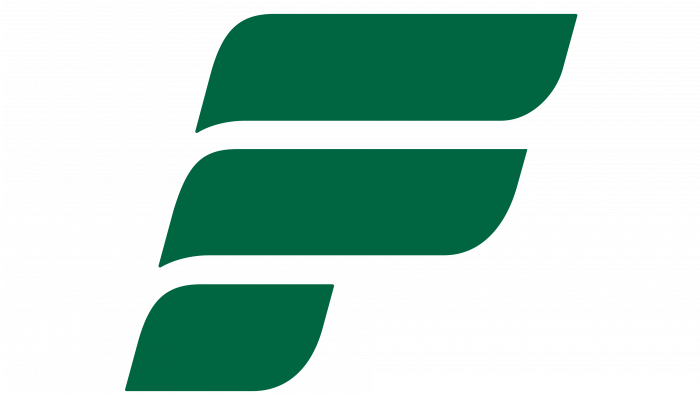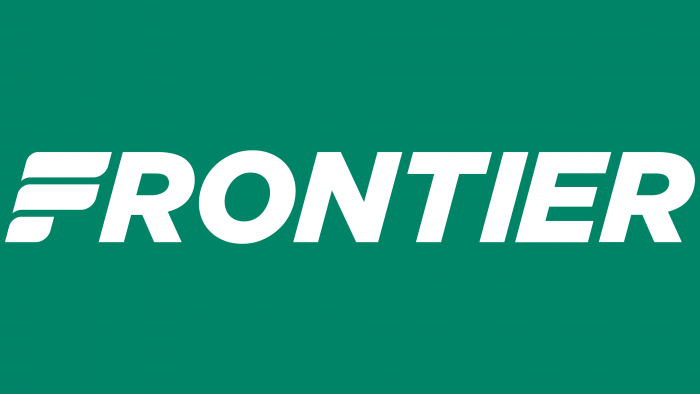The Frontier Airlines logo stands for safe travel. Promises a smooth takeoff and landing. The company prioritizes passenger safety. The emblem also hints at a special “green” offer for airlines with free transportation.
Frontier Airlines: Brand overview
Frontier Airlines links cities in the United States, the Dominican Republic, Mexico, and Canada. It is based in Denver and flies to over 100 destinations, serving about 90% of the United States population. Its fleet is constantly replenished with new air transport, and Frontier Airlines’ aircraft have never been in a fatal situation. In terms of pricing, this organization is considered low-cost and, to some extent, imitates Spirit Airlines, offering customers affordable fares.
Frontier Airlines embarked on its journey in the skies on February 8, 1994, in Denver, Colorado, fueled by the aspirations of former Continental Airlines employees. The airline’s first flight took place on July 5, 1994, transporting passengers from Denver to North Platte, Nebraska, aboard a Boeing 737-200. Initially, Frontier Airlines operated on four routes from Denver.
By 1995, the company expanded its reach, adding new destinations such as Albuquerque, El Paso, and Phoenix. It debuted on the NASDAQ stock exchange in 1998, marking a significant financial milestone.
A pivotal change occurred in 1999 when the brand placed orders for new Airbus A319 aircraft, with the first delivery arriving in 2001. The early 2000s saw rapid growth as the airline extended its network to the United States East Coast and Mexico.
2003, the company launched the EarlyReturns loyalty program to reward frequent flyers. In 2006, it created Lynx Aviation, a subsidiary operating Bombardier Q400 turboprops, which allowed the airline to service smaller cities.
The brand’s financial challenges of 2008 led to its filing for Chapter 11 bankruptcy. Despite this setback, operations continued, and by October 2009, Republic Airways Holdings had guided the company out of bankruptcy.
In 2011, the airline transitioned to an ultra-low-cost model, reducing expenses and lowering base fares. This strategic shift gained momentum in 2013 when Indigo Partners acquired the brand, leading to further cost-efficient transformations.
In 2014, the company introduced a new branding initiative featuring a variety of animals on aircraft tails, symbolizing its fresh identity. This rebranding coincided with a significant fleet upgrade, including orders for 12 Airbus A320neo and 18 Airbus A321ceo aircraft in 2015.
A major expansion was announced in 2017, adding 21 new destinations to the airline’s network. The fleet welcomed its first Airbus A320neo in 2018, enhancing operational efficiency.
In 2019, the company made a substantial move by ordering 100 Airbus A320neo aircraft, highlighting its plans for future growth.
Throughout its evolution, the airline has been recognized for its innovative approach to low-cost travel and commitment to eco-friendly operations. By 2020, its network included over 100 destinations across the US, Mexico, and the Caribbean, supported by a fleet of more than 100 Airbus aircraft.
Meaning and History
The history of the air transport enterprise has been divided into two periods: the first began in 1950 and ended in 1986, and the second lasted from 1994 to the present. The original Frontier carried about 87 million passengers before it filed for bankruptcy and merged with Continental Airlines. The last aircraft with the iconic Frontier Airlines logo on board took off in 1986.
In the early 1990s, several former Frontier employees co-founded AeroDenver Travel Services with an ex-United Airlines pilot. Almost immediately, the Denver company was renamed Frontier Airlines. In addition to the name and base of the bankrupt enterprise, she inherited its symbols. This happened in 2014 when designers gave the classic Saul Bass emblem a second life.
Old and New Frontier are two different airlines with the same name. Although the existing organization leaders have tried to connect them at the branding level, they do not have a common history. The airline’s current logo is a tribute to the classic style. It is combined with the aircraft tail section’s modern design, which has depicted wild animals since 1994.
The emblem has undergone several dramatic changes, as it was modernized with delays in several periods. However, the designers have tied the old and new versions of the logo, choosing the legendary icon of a bird’s wing to replace the letter “F.”
What is Frontier Airlines?
Frontier Airlines is an American airline based in Denver, Colorado, owned by Indigo Partners, a private equity firm. Frontier Airlines is a low-budget US territorial airline with domestic flights. More than 100 settlements are known to which it flies. Among them are Trenton, Orlando, Denver, Las Vegas, Miami, Philadelphia, Atlanta, and others. In addition, it serves 31 overseas destinations. The air carrier was founded in 1994 and is the technical brand of Indigo Partners. The location of the air transport company is the city of Denver, where it has a hub airport. The company is now in a difficult situation because it took a quarter of a million dollars to compensate for the financial damage caused by the pandemic outbreak. The reason is the coronavirus pandemic, which has limited movement around the country and flights abroad.
1958 – 1972
In 1958, Lewis Bergman Maytag, Jr. became the majority shareholder of Frontier Airlines. The oldest logo, the predecessor of the modern airline, features a flying arrow with half-segments. The halves represent the tip and tail. This special visual trick makes the arrow resemble as much as possible an airplane directed forward. Behind him, a thin golden line stretches, indicating the trajectory of the flight and the trail in the sky. The emblem also has a boomerang – a symbol of forwarding movement with backward movement. It is an allegory of performing round-trip flights (in two directions). This makes the logo dynamic. Below is the Frontier Airlines italic lettering in flat capital letters. The palette is borrowed from nature itself: gold (the color of the sun) and blue (the color of the sky). The new symbol adorned the side of the Convair CV-340 aircraft in 1959. By the way, the first logo with a winged arrow appeared in 1950, but it was red-green and had a different design.
1978 – 1986
This emblem was created by renowned director Saul Bass, who has collaborated with celebrities such as Billy Wilder and Alfred Hitchcock. He also designed some of the most stylish emblems in the aviation industry, including those of United Airlines and Continental Airlines. The designer tried to make the logo of this period radically different from the previous version.
It features a stylized “F” in the form of a bird’s wing of three-wide feathers. White horizontal stripes of different lengths are located in a red circle. Below is the carrier’s name, written in strict block letters, sans serif. Special emphasis is placed on the “R,” the right side of which is not connected to the left leg.
This symbol was introduced on April 30, 1978, and remained used until 1986, when the company went out of business.
1994 – 2001
After the airline rebooted with a re-launch in the profile market, it left the old name but took on a new logo. This is understandable—its founders were a group of individuals who headed Aeroflot’s previous structure. The founders invited another specialist to create a personal identity to make the past and modern organizations somehow different. Therefore, the author of this emblem is the designer Dan Cotton. He proposed a different concept based on a dark blue rectangle with white lettering inside.
The title spans two lines. Above is the word “Frontier,” which is made in italics of uneven height. The “jumping” letters outwardly resemble the trail of an airplane, as it is painted in films and animated films. The font is semi-connected, grotesque, individual. To emphasize the originality of the air transport company, the author of the logo made the uppercase “F” and the lowercase “t,” beating them with straight, elongated lines. In the second line, he put the word “Airlines.” It is written in a classic wide-spacing serrated typeface.
2001 – 2014
This period is characterized by a highly legible emblem with clear capital letters. The developer changed the handwritten style to the printed style, which made the inscription immediately gain versatility: it is visible and understandable at first glance, which was not the case in the previous version. Despite this adjustment, the authors did not use serifs – they settled on a chopped typeface with wide lines.
In addition, a dark color stands out better against a light background than a light color against a dark background. Thanks to the white color of the backing, the logo could be opened —to make it limitless (without frames), which is symbolic of an air transport company. The second half of the name is made in small and thin letters. The predominant colors at this time were green, black, and white.
2014 – today
At the end of 2013, the airline was acquired by the Indigo Partners LLC group led by Bill Franke. The new owners decided to change their business strategy, so they simplified the tariff structure and ordered a new livery for Frontier aircraft from PS: Studios, Inc. The designers have given the Saul Bass emblem a second life to highlight the brand’s history. They included it in the inscription, using it instead of the first letter.
The icon consists of three stripes of different lengths, reminiscent of a bird’s wing. The developers used an italic font to balance the elements but did not use the handwritten style. The inscription is still in printable sans-serif characters in geometrically proportional letters. Instead of the traditional “F,” there is a brand name. Below the word “Frontier,” there is “Airlines”—in the lower-left corner, between “T” and “R.”
Frontier Airlines: Interesting Facts
Frontier Airlines, an American ultra-low-cost airline, stands out in the aviation industry for its focus on customer service, cost efficiency, and unique marketing strategies.
- Beginnings: Launched in 1994, Frontier began with a few routes and has grown to fly to over 100 places in the U.S. and the Americas. It took its name from an earlier airline that stopped operating in 1986.
- Distinctive Planes: Frontier’s aircraft are famous for their animal-themed tail art, which features North American wildlife like foxes and bears, making its planes easily recognizable.
- Eco-Friendly: The airline prioritizes being green and using fuel-efficient Airbus A320neo aircraft to reduce fuel use and environmental impact.
- Denver-Based: Though Frontier is headquartered in Denver, Colorado, it uses Denver International Airport as a central hub for its flights.
- Low-Cost Model: Frontier keeps ticket prices low but charges for add-ons such as seat selection and baggage. This approach lets passengers choose and pay for only the services they want.
- Extra Legroom Option: Frontier offers “Stretch Seating” with more legroom, available for an additional fee for those who value comfort.
- Booking Benefits: Booking directly through Frontier’s website guarantees the lowest prices. Members of the FRONTIER Miles program can earn points redeemable for flights, encouraging direct bookings.
- Tech-Savvy: Frontier uses technology to improve customer service and efficiency, offering features like mobile boarding passes and an easy booking system.
- Loyalty Program: The FRONTIER Miles program rewards frequent flyers with perks like priority boarding and free flight miles, enhancing the value of flying with Frontier over time.
- Community Involvement: The airline supports local events, charities, and initiatives, showing its dedication to the communities it serves.
Frontier Airlines is recognized for its affordable prices, environmental efforts, innovative services, and unique branding, establishing itself as a key player in the budget travel market.
Font and Colors
The airline’s current symbol is a tribute to its past, even though the new brand is only formally associated with the old Frontier Airlines. Visual identity is based on the geometric F-shaped badge invented by Saul Bass in 1978.
The logo was presented in September 2014 at the presentation of the Airbus A320-214 N227FR aircraft. The designers returned the iconic Frontier F and the arrow pointing forward, referencing the original emblem, which first appeared aboard the Douglas DC-3 in 1950. The retrospective approach integrates past and future, although a stylized “F” in the word mark impairs legibility.
The icon of three curved shapes is combined with the grotesque, geometric Gotham. American typographer Tobias Frere-Jones designed this font family in collaboration with Jesse Ragan. The inspiration comes from the signs on old buildings in New York. The Frontier Airlines logo features a bold version of Gotham, with the first word in italics. A slight tilt to the right symbolizes forward movement.
The first logos used a typeface reminiscent of Moki Soft with differences in the letters “F” and “R.” In modern versions, the inscription is made in fonts that almost coincide with Magnum Sans Black and JT Leonor Extra Bold Italic.
The American airline switched to green in 1994. Designers from PS: Studios, Inc. kept this palette but chose a new shade (# 318468), close to dark turquoise. And they made the word “AIRLINES” light gray (# 9E9A97).
About Company
The roots of this airline go deep into history because it was founded in 1959 and existed until 1972. Then it had a short period of stagnation, followed by a resumption of work in 1978. However, in 1986, Frontier Airlines ceased operations again, merging with Continental Airlines. Designer Saul Bass designed the logos for both airlines.
The re-creators of the aviation service were United Airlines pilot Frederick W. “Rick” Brown, his wife Janice Brown, and Bob Schulman. When Continental Airlines began to reduce international flights from Denver airport in 1993, the three formed charter firm AeroDenver Travel Services to meet the public’s demand on international destinations. They invited M.C. “Hank” Lund, the former CEO of the former Frontier Airlines. At the same time, the airline adopted its former name – Frontier Airlines. Its registration took place in the winter of 1994.
Like its prototype company of the same name, the new Frontier had a hub in Denver and for nine years used the motto “The Spirit of the West,” which was written in italics above the portholes. And the word “Frontier” was on the fuselage of all her aircraft. By the early 2000s, the carrier improved its aircraft fleet and expanded its route network. However, in 2020, the company found itself on the verge of collapse due to lawsuits brought against it when it did not want to compensate for the cost of tickets to passengers who could not fly due to the outbreak of COVID-19.
FAQ
What is the Frontier mascot?
Frontier Airlines’ mascot is Grizwald, the bear. Grizwald exemplifies the brand’s adventurous and friendly spirit. As the face of the airline’s marketing, Grizwald appears in advertisements and social media posts to create a memorable image for customers.
Grizwald’s character appeals to families and travelers seeking a fun, affordable flying experience. The mascot is featured in stories and visuals highlighting the brand’s commitment to making travel enjoyable and accessible.
What is Frontier airline code?
The company code is F9. This code helps identify the brand in airline systems and when booking travel. Awarded by the International Air Transport Association (IATA), it ensures proper management of bookings, baggage, and other services.
Codes are vital for organizing flight information, ticketing, and baggage handling. When you book a flight with this brand, the F9 code manages your booking and related services.
Which airline is Frontier?
Frontier is a large American ultra-low-cost airline based in Denver, Colorado. The brand flies to more than 100 destinations in the United States and 31 international destinations. It employs more than 3,000 people. The company focuses on providing affordable travel options with good service, making it popular among budget travelers. The airline’s network covers many major cities and holiday destinations.
The brand is known for its animal-themed airplane tails, which make its planes easily recognizable. This unique branding helps Frontier stand out in the competitive airline market. The company’s low fares, efficient operations, and customer-focused service have made it an important player in American aviation.
What is the logo for Frontier Airlines?
The airline’s logo is a text logo that shows its full name. The top is bold and wide, while the bottom is thin and small. Both parts use sleek sans-serif fonts for a modern and clean look.
Instead of the letter F, the logo features a winged symbol. This symbol connects the brand’s past and present, highlighting its history and evolution. The winged design emphasizes the airline’s aviation character and adds dynamism, making the logo memorable and easily recognizable in the aviation industry.
What font does Frontier Airlines use?
The airline uses different fonts for its logos. The previous logo used Franklin Gothic Heavy and Franklin Gothic Book, while the current logo uses Gotham. These fonts were chosen for their clean and modern look, keeping with the brand’s style.
Franklin Gothic fonts gave the old logo a bold and strong appearance. The current Gotham font looks elegant and modern. This change in fonts helps the airline maintain a fresh and professional image, reflecting its efforts to stay current and appealing to customers.
